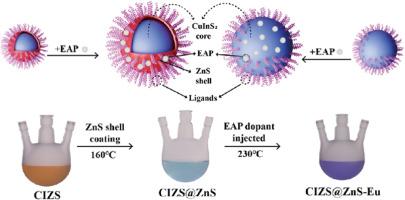Enhanced luminescence through doping of CuInZnS core-shell quantum dots with Eu
IF 3.6
3区 物理与天体物理
Q2 OPTICS
引用次数: 0
Abstract
Due to the quantum confinement effect, the quantum dots (QDs) behave distinguished photo-/electro-luminescence property. However, due to so small size with 3–5 nm diameter, their surface defects cause spectral limitation and luminescent instabilities, which inhibited the applications of QDs in key areas. It should be very interesting if rich luminescence spectra of lanthanides can be used to enhance the emission and to extend the spectra of sulfide-base QDs. However, the sulfur repellency of lanthanide ions (such as Eu3+) is the negative factor. In this work, we incorporated lanthanide ions (Eu3+) complexes into QDs to realize this. Diketone (i.e., acetylacetone (ACAC)) and phenanthroline (Phen) were chosen as the ligands of Eu3+ (i.e., Eu) chlorides. The experimental data indicated that the incorporating Eu3+ complexes into the ZnS-modified CIZS QDs resulted in double enhancement of the luminescent intensity, the blue-shift of emission wavelength from 637 to 575 nm, the PLQY increase from 55.94 % to 81.56 %. Simultaneously, the Zn2+ in the shell, under the influence of the Eu3+, reacted with oxygen vacancies in the environment. XRD shows the characteristic peaks of ZnO, indicating the formation of ZnO QDs.

铕掺杂CuInZnS核壳量子点增强发光性能
由于量子约束效应,量子点表现出独特的光/电致发光特性。然而,由于量子点的尺寸很小,直径只有3-5 nm,其表面缺陷造成了光谱限制和发光不稳定,阻碍了量子点在关键领域的应用。如果利用镧系元素丰富的发光光谱来增强发射和扩展硫化物基量子点的光谱,这将是非常有趣的。然而,镧系离子(如Eu3+)的拒硫性是负面因素。在这项工作中,我们将镧系离子(Eu3+)配合物加入量子点中来实现这一目标。选择二酮(即乙酰丙酮(ACAC))和菲罗啉(Phen)作为Eu3+(即Eu)氯化物的配体。实验数据表明,将Eu3+配合物掺入zns修饰的CIZS量子点中,发光强度加倍增强,发射波长从637 nm蓝移到575 nm, PLQY从55.94%提高到81.56%。同时,壳层中的Zn2+在Eu3+的影响下,与环境中的氧空位发生反应。XRD显示ZnO的特征峰,表明ZnO量子点的形成。
本文章由计算机程序翻译,如有差异,请以英文原文为准。
求助全文
约1分钟内获得全文
求助全文
来源期刊

Journal of Luminescence
物理-光学
CiteScore
6.70
自引率
13.90%
发文量
850
审稿时长
3.8 months
期刊介绍:
The purpose of the Journal of Luminescence is to provide a means of communication between scientists in different disciplines who share a common interest in the electronic excited states of molecular, ionic and covalent systems, whether crystalline, amorphous, or liquid.
We invite original papers and reviews on such subjects as: exciton and polariton dynamics, dynamics of localized excited states, energy and charge transport in ordered and disordered systems, radiative and non-radiative recombination, relaxation processes, vibronic interactions in electronic excited states, photochemistry in condensed systems, excited state resonance, double resonance, spin dynamics, selective excitation spectroscopy, hole burning, coherent processes in excited states, (e.g. coherent optical transients, photon echoes, transient gratings), multiphoton processes, optical bistability, photochromism, and new techniques for the study of excited states. This list is not intended to be exhaustive. Papers in the traditional areas of optical spectroscopy (absorption, MCD, luminescence, Raman scattering) are welcome. Papers on applications (phosphors, scintillators, electro- and cathodo-luminescence, radiography, bioimaging, solar energy, energy conversion, etc.) are also welcome if they present results of scientific, rather than only technological interest. However, papers containing purely theoretical results, not related to phenomena in the excited states, as well as papers using luminescence spectroscopy to perform routine analytical chemistry or biochemistry procedures, are outside the scope of the journal. Some exceptions will be possible at the discretion of the editors.
 求助内容:
求助内容: 应助结果提醒方式:
应助结果提醒方式:


